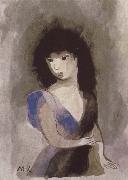Wholesale Oil Painting No Minimum |
|||||||||||
|
|
|||||||||||

|
|||||||||||
|
|
|
||||||||
Marie LaurencinFrench Painter, ca.1885-1956 French painter, stage designer and illustrator. After studying porcelain painting at the Sevres factory (1901) and drawing in Paris under the French flower painter Madelaine Lemaire (1845-1928), in 1903-4 she studied at the Academie Humbert in Paris, where she met Georges Braque and Francis Picabia. In 1907 she first exhibited paintings at the Salon des Independants, met Picasso at Clovis Sagot gallery and through Picasso was introduced to the poet Guillaume Apollinaire. Laurencin and Apollinaire were soon on intimate terms, their relationship lasting until 1912. |
||||||||
|
|
||||||||
Bust of woman
Bust of woman Painting ID:: 52886 |
mk224
16x11cm
1950
mk224 16x11cm 1950 |
|||||||
|
|
||||||||
|
pablo picasso Pablo Diego Josee Francisco de Paula Juan Nepomuceno Mareea de los Remedios Cipriano de la Sant??sima Trinidad Martyr Patricio Clito Rueez y Picasso (25 October 1881 C 8 April 1973) was an Andalusian-Spanish painter, draughtsman, and sculptor. As one of the most recognized figures in twentieth-century art, he is best known for co-founding the Cubist movement and for the wide variety of styles embodied in his work. Among his most famous works are the proto-Cubist Les Demoiselles d Avignon (1907) and his depiction of the German bombing of Guernica during the Spanish Civil War, Guernica (1937). Picasso was baptized Pablo Diego Josee Francisco de Paula Juan Nepomuceno Mareea de los Remedios Cipriano de la Santesima Trinidad Clito, a series of names honouring various saints and relatives. Added to these were Rueez and Picasso, for his father and mother, respectively, as per Spanish custom. Born in the city of Melaga in the Andalusian region of Spain, he was the first child of Don Josee Ruiz y Blasco (1838?C1913) and Marea Picasso y Lepez. Picassoes family was middle-class; his father was also a painter who specialized in naturalistic depictions of birds and other game. For most of his life Ruiz was a professor of art at the School of Crafts and a curator of a local museum. Ruizes ancestors were minor aristocrats. The young Picasso showed a passion and a skill for drawing from an early age; according to his mother, his first words were epiz, pize, a shortening of lepiz, the Spanish word for epencile. From the age of seven, Picasso received formal artistic training from his father in figure drawing and oil painting. Ruiz was a traditional, academic artist and instructor who believed that proper training required disciplined copying of the masters, and drawing the human body from plaster casts and live models. His son became preoccupied with art to the detriment of his classwork. The family moved to La Coruna in 1891 so his father could become a professor at the School of Fine Arts. They stayed almost four years. On one occasion the father found his son painting over his unfinished sketch of a pigeon. Observing the precision of his sones technique, Ruiz felt that the thirteen-year-old Picasso had surpassed him, and vowed to give up painting. In 1895, Picasso seven-year old sister, Conchita, died of diphtheria - a traumatic event in his life.After her death, the family moved to Barcelona, with Ruiz transferring to its School of Fine Arts. Picasso thrived in the city, regarding it in times of sadness or nostalgia as his true home. Ruiz persuaded the officials at the academy to allow his son to take an entrance exam for the advanced class. This process often took students a month, but Picasso completed it in a week, and the impressed jury admitted Picasso, who was still 13. The student lacked discipline but made friendships that would affect him in later life. His father rented him a small room close to home so Picasso could work alone, yet Ruiz checked up on him numerous times a day, judging his sones drawings. The two argued frequently. Picassoes father and uncle decided to send the young artist to Madrides Royal Academy of San Fernando, the foremost art school in the country. In 1897, Picasso, age 16, set off for the first time on his own. Yet his difficulties accepting formal instruction led him to stop attending class soon after enrollment. Madrid, however, held many other attractions: the Prado housed paintings by the venerable Diego Velezquez, Francisco Goya, and Francisco Zurbaren. Picasso especially admired the works of El Greco; their elements, like elongated limbs, arresting colors, and mystical visages, are echoed in Picassoes œuvre. bust of woman mk289 1943 oil on canvas 73x60cm private collection |
||||||||
|
|
||||||||
|
Prev Next
|
||||||||
|
|
||||||||
|
Related Paintings to pablo picasso :. |
||||||||
|
|
||||||||
|
CONTACT US |

